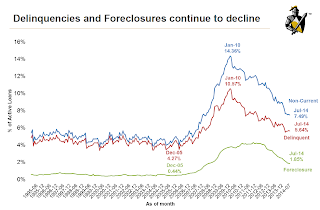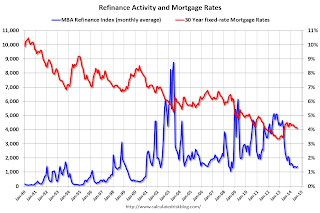by Calculated Risk on 9/02/2014 10:06:00 AM
Tuesday, September 02, 2014
ISM Manufacturing index increases to 59.0 in August
The ISM manufacturing index suggests faster expansion in August than in July. The PMI was at 59.0% in August, up from 57.1% in July. The employment index was at 58.1%, down slightly from 58.2% in July, and the new orders index was at 66.7%, up from 63.4% in July.
From the Institute for Supply Management: August 2014 Manufacturing ISM® Report On Business®
Economic activity in the manufacturing sector expanded in August for the 15th consecutive month, and the overall economy grew for the 63rd consecutive month, say the nation's supply executives in the latest Manufacturing ISM® Report On Business®.
The report was issued today by Bradley J. Holcomb, CPSM, CPSD, chair of the Institute for Supply Management® (ISM®) Manufacturing Business Survey Committee. "The August PMI® registered 59 percent, an increase of 1.9 percentage points from July's reading of 57.1 percent, indicating continued expansion in manufacturing. This month's PMI® reflects the highest reading since March 2011 when the index registered 59.1 percent. The New Orders Index registered 66.7 percent, an increase of 3.3 percentage points from the 63.4 percent reading in July, indicating growth in new orders for the 15th consecutive month. The Production Index registered 64.5 percent, 3.3 percentage points above the July reading of 61.2 percent. The Employment Index grew for the 14th consecutive month, registering 58.1 percent, a slight decrease of 0.1 percentage point below the July reading of 58.2 percent. Inventories of raw materials registered 52 percent, an increase of 3.5 percentage points from the July reading of 48.5 percent, indicating growth in inventories following one month of contraction. The August PMI® is led by the highest recorded New Orders Index since April 2004 when it registered 67.1 percent. At the same time, comments from the panel reflect a positive outlook mixed with caution over global geopolitical unrest.
emphasis added
 Click on graph for larger image.
Click on graph for larger image.Here is a long term graph of the ISM manufacturing index.
This was solidly above expectations of 56.8%. The employment index was strong - and the new orders index was at the highest level since April 2004.
Very strong report.
Black Knight releases Mortgage Monitor for July
by Calculated Risk on 9/02/2014 12:40:00 AM
Black Knight Financial Services (BKFS) released their Mortgage Monitor report for July today. According to BKFS, 5.64% of mortgages were delinquent in July, down from 5.70% in June. BKFS reports that 1.85% of mortgages were in the foreclosure process, down from 2.82% in July 2013.
This gives a total of 7.49% delinquent or in foreclosure. It breaks down as:
• 1,713,000 properties that are 30 or more days, and less than 90 days past due, but not in foreclosure.
• 1,136,000 properties that are 90 or more days delinquent, but not in foreclosure.
• 935,000 loans in foreclosure process.
For a total of 3,785,000 loans delinquent or in foreclosure in June. This is down from 4,599,000 in July 2013.

This graph from BKFS shows percent of loans delinquent and in the foreclosure process over time.
Delinquencies and foreclosures are moving down - and might be back to normal levels in a couple of years.

From Black Knight:
July’s data also showed continued improvement in new problem loans, which, at 0.6% of active loans, are now firmly back to 2005-2006 levels. Likewise, “roll rates” (the number of loans that shift from current into progressively more delinquent statuses) have been improving over the long term across all categories. Black Knight has observed roll rates increasing on loans shifting from 60 to 90 days delinquent and from 90 days to foreclosure over the last four months. It should be noted, however, that nearly 75 percent of 90-day defaults and almost 80 percent of foreclosure starts are from loans originated in 2008 and earlier.There is much more in the mortgage monitor.
emphasis added
Monday, September 01, 2014
State and Local Governments: Contributions to GDP and Employment
by Calculated Risk on 9/01/2014 11:00:00 AM
Two and half years ago I argued that "most of the drag from state and local governments would be over by mid-year 2012. Just eliminating the drag from state and local governments would help GDP and employment growth". This has been an important change.
Here is a graph showing the contribution to percent change in GDP for residential investment and state and local governments since 2005.

The blue bars are for residential investment (RI), and RI was a significant drag on GDP for several years. RI (blue) added to GDP growth for a few years, before subtracting in Q4 2013 and Q1 2014. RI bounced back in Q2, and since RI is still very low, I expect RI to make a positive contribution to GDP for some time.
State and local governments had been a drag on GDP for several years (red). Although not as large a negative as the worst of the housing bust (and much smaller spillover effects), this decline was relentless and unprecedented.
Now the contribution from state and local governments has been positive for 5 of the last 6 quarters.
 The second graph shows total state and government payroll employment since January 2007. State and local governments lost jobs for four straight years, but the decline slowed sharply in 2012. (Note: Scale doesn't start at zero to better show the change.)
The second graph shows total state and government payroll employment since January 2007. State and local governments lost jobs for four straight years, but the decline slowed sharply in 2012. (Note: Scale doesn't start at zero to better show the change.)
In July 2014, state and local governments added 11,000 jobs. State and local government employment is now up 151,000 from the bottom, but still 593,000 below the peak.
It is pretty clear that state and local employment is now increasing. Note: Federal government layoffs have slowed (unchanged in July), but Federal employment is still down 22,000 for the year.
I expect state and local governments to make a positive contribution going forward.
Sunday, August 31, 2014
Mortgage Rates: A Long Way to Fall for a Significant Increase in Refinance Activity
by Calculated Risk on 8/31/2014 09:26:00 PM
I've seen some recent discussion suggesting that mortgage refinance activity might pickup significantly if mortgage rates fall just a little more. I think this is incorrect.
First, from Freddie Mac last week: Mortgage Rates Remain Low Heading Into Holiday Weekend
Freddie Mac ... released the results of its Primary Mortgage Market Survey® (PMMS®), showing average fixed mortgage rates largely unchanged amid mixed news on the housing front heading into the Labor Day weekend.
...
30-year fixed-rate mortgage (FRM) averaged 4.10 percent with an average 0.5 point for the week ending August 28, 2014, unchanged from last week. A year ago at this time, the 30-year FRM averaged 4.51 percent.
15-year FRM this week averaged 3.25 percent with an average 0.6 point, up from last week when it averaged 3.23 percent. A year ago at this time, the 15-year FRM averaged 3.54 percent.
 Click on graph for larger image.
Click on graph for larger image.This graph shows the 30 year fixed rate mortgage interest rate from the Freddie Mac Primary Mortgage Market Survey® compared to the MBA refinance index.
The refinance index dropped sharply last year when mortgage rates increased. Historically refinance activity picks up significantly when mortgage rates fall about 50 bps from a recent level.
Sure, borrowers who took out mortgages last year can probably refinance now - but that is a small number of total borrowers. For a significant increase in refinance activity, rates would have to fall below the late 2012 lows (on a monthly basis, 30 year mortgage rates were at 3.35% in the PMMS in November and December 2012.
The second graph shows the relationship between the monthly 10 year Treasury Yield and 30 year mortgage rates from the Freddie Mac survey.
 Currently the 10 year Treasury yield is at 2.34% and 30 year mortgage rates are at 4.10% (according to the Freddie Mac survey). Based on the relationship from the graph, the 30 year mortgage rate (Freddie Mac survey) would be around 3.5% when 10-year Treasury yields are around 1.4% (unlikely any time soon).
Currently the 10 year Treasury yield is at 2.34% and 30 year mortgage rates are at 4.10% (according to the Freddie Mac survey). Based on the relationship from the graph, the 30 year mortgage rate (Freddie Mac survey) would be around 3.5% when 10-year Treasury yields are around 1.4% (unlikely any time soon).To really have a refinance boom, 10-year Treasury yields would have to fall to 1% or so!
So I don't expect a significant increase in refinance activity any time soon.
Restaurant Performance Index declined in July
by Calculated Risk on 8/31/2014 12:49:00 PM
From the National Restaurant Association: Restaurant Performance Index Dipped in July
Due in part to a dampened outlook among restaurant operators, the National Restaurant Association’s Restaurant Performance Index (RPI) registered a modest decline in July. The RPI – a monthly composite index that tracks the health of and outlook for the U.S. restaurant industry – stood at 101.0 in July, down from a level of 101.3 in June and the second consecutive monthly decline. Despite the recent downticks, the RPI remained above 100 for the 17th consecutive month, which signifies expansion in the index of key industry indicators.
“Although restaurant operators reported positive same-store sales and customer traffic results in July, the RPI edged down as a result of a mixed outlook for the months ahead,” said Hudson Riehle, senior vice president of the Research and Knowledge Group for the Association. “Restaurant operators were less bullish about the direction of the overall economy, and rising wholesale food costs are once again starting to pose a significant challenge.”
emphasis added
 Click on graph for larger image.
Click on graph for larger image.The index decreased to 101.0 in July, down from 101.3 in June. (above 100 indicates expansion).
Restaurant spending is discretionary, so even though this is "D-list" data, I like to check it every month. Even with the recent declines in the index, this is still a decent level.


